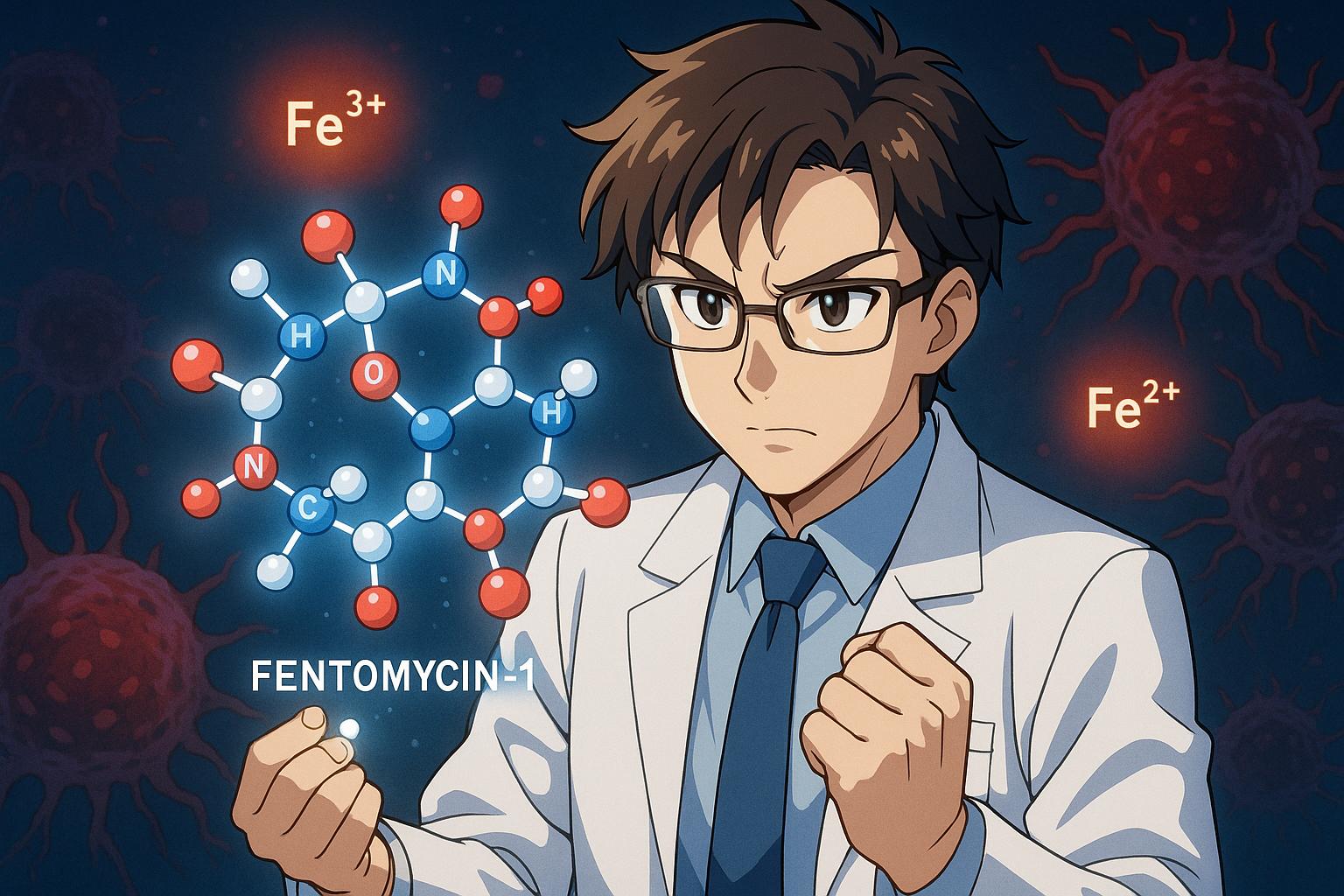After leaving medical school, Raphael Rodriguez shifted focus to drug discovery, creating Fentomycin-1, a novel compound that exploits cancer cells’ iron dependence to induce ferroptosis and potentially halt metastasis, showing early promise against aggressive tumours in preclinical tests.
When Raphael Rodriguez made the bold decision to leave medical school after just one year, he was thrust into a period of deep reflection about his future. Despite giving up on the traditional pathway to becoming a clinician, he was resolute about finding other ways to help people. “I knew I was still destined to help people somehow,” he remarked, understanding that his strengths lay not in patient care but in scientific exploration. This pivotal shift led him to immerse himself in research, collaborating with leading organic chemists at institutions such as Oxford and Cambridge.
In the laboratory, Rodriguez discovered a transformative insight: the potential for drug development could allow him to impact countless lives, far beyond his reach as a practising physician. “Very quickly, I realized that when you know what compound to make, and if you’re capable of making it, then you might be able to pull out a drug and cure many more people than you if you want to be a clinician,” he explained. This epiphany resulted in the crafting of Fentomycin-1, an innovative compound engineered to combat one of cancer’s most lethal strategies: its ability to metastasize.
Metastasis—the process by which cancer cells spread to other parts of the body—accounts for at least 70 percent of cancer fatalities. This staggering statistic underscores the urgent need for therapies that target metastatic disease directly. Rodriguez observed that existing treatments often fall short, as they primarily focus on primary tumours rather than the root cause of cancer-related mortality: the spread of cancer cells. “The treatments we have are not sufficient — they are not designed to target metastasis,” he noted.
His research highlights a curious paradox: cancer cells actively hoard iron in their lysosomes, making them more aggressive but also revealing a critical vulnerability. This accumulation of iron can trigger ferroptosis, a form of programmed cell death. “We conceptualize the fact that cancer cells can exploit iron chemistry to adapt, to change identity, to be plastic, to become invasive,” Rodriguez stated, indicating an innovative angle for therapeutic intervention.
The mechanism behind Fentomycin-1 leverages this intrinsic link between iron and ferroptosis. In early laboratory tests, Rodriguez’s team witnessed remarkable results: metastatic cancer cells were decimated within 12 hours. “At this point in time, cancer patients are dying — specifically in this population [with these cancers],” Rodriguez reflected, expressing their satisfaction in developing a compound that shows such promise in targeting aggressive cancer forms.
In preclinical studies, Fentomycin-1 demonstrated effectiveness against challenging cancer types, notably pancreatic cancer, breast cancer, and sarcomas. These forms are notorious for their resistance to existing therapies and high iron content. The drug not only slowed tumour growth in mice but also activated the immune system — offering a potential synergistic effect when used alongside conventional treatments. Rodriguez’s team conducted tests on tumour samples taken directly from patients, observing a reduction in CD44, a protein linked to drug resistance and metastasis.
Fentomycin-1’s unique mechanism of action targets cancer cells with high iron levels while leaving healthy tissue largely unharmed. While the initial outcomes are promising, further research is essential before transitioning to clinical trials. Rodriguez emphasised the need for funding to advance this research phase, stating, “At this point in time, we are happy with the compound we made.” As much as the excitement for the breakthrough persists, practical considerations loom large. Questions regarding the stability, bioavailability, and potential side effects of the compound in live human systems remain to be answered.
Currently, the implications of this research could extend far beyond laboratory success. Given the projected increase in metastatic cancer cases in the United States—nearly 700,000 anticipated by 2025—the urgency to explore new avenues for effective treatment has never been more evident. As Rodriguez and his team continue their journey, their work may yet illuminate a path toward significantly improved cancer therapies, paving the way for novel strategies to combat one of humanity’s most challenging diseases.
As these efforts unfold, the medical and scientific communities await new insights that could reshape the landscape of cancer treatment, marking a defining moment in the fight against metastatic cancer.
Reference Map
- Paragraphs 1-3
- Paragraphs 4-6
- Paragraphs 7-9
- Paragraphs 10-13
Source: Noah Wire Services
- https://www.dailymail.co.uk/health/article-14740251/medical-school-dropout-end-cancer-deaths-iron.html?ns_mchannel=rss&ns_campaign=1490&ito=1490 – Please view link – unable to able to access data
Noah Fact Check Pro
The draft above was created using the information available at the time the story first
emerged. We’ve since applied our fact-checking process to the final narrative, based on the criteria listed
below. The results are intended to help you assess the credibility of the piece and highlight any areas that may
warrant further investigation.
Freshness check
Score:
10
Notes:
The narrative is based on a recent press release from Institut Curie, dated 7 May 2025, detailing the development of Fentomycin-1 by Raphaël Rodriguez and his team. ([institut-curie.org](https://institut-curie.org/publications/activation-lysosomal-iron-triggers-ferroptosis-cancer?utm_source=openai)) This indicates high freshness, as the information is current and directly sourced from the research institution.
Quotes check
Score:
10
Notes:
The direct quotes attributed to Raphaël Rodriguez in the narrative are consistent with those found in the press release from Institut Curie. ([institut-curie.org](https://institut-curie.org/publications/activation-lysosomal-iron-triggers-ferroptosis-cancer?utm_source=openai)) This suggests that the quotes are accurately reproduced, supporting the authenticity of the content.
Source reliability
Score:
10
Notes:
The narrative originates from a reputable source, Institut Curie, a leading French research institution. The press release is accessible on their official website, confirming the credibility of the information. ([institut-curie.org](https://institut-curie.org/publications/activation-lysosomal-iron-triggers-ferroptosis-cancer?utm_source=openai))
Plausability check
Score:
10
Notes:
The claims made in the narrative align with the findings reported in the press release from Institut Curie. The development of Fentomycin-1, a compound targeting cancer metastasis through ferroptosis, is consistent with current scientific research in the field. ([institut-curie.org](https://institut-curie.org/publications/activation-lysosomal-iron-triggers-ferroptosis-cancer?utm_source=openai))
Overall assessment
Verdict (FAIL, OPEN, PASS): PASS
Confidence (LOW, MEDIUM, HIGH): HIGH
Summary:
The narrative is based on a recent and credible press release from Institut Curie, detailing the development of Fentomycin-1 by Raphaël Rodriguez and his team. The quotes are consistent with the press release, and the claims are plausible and supported by the source. Therefore, the narrative passes the fact-checking criteria with high confidence.













